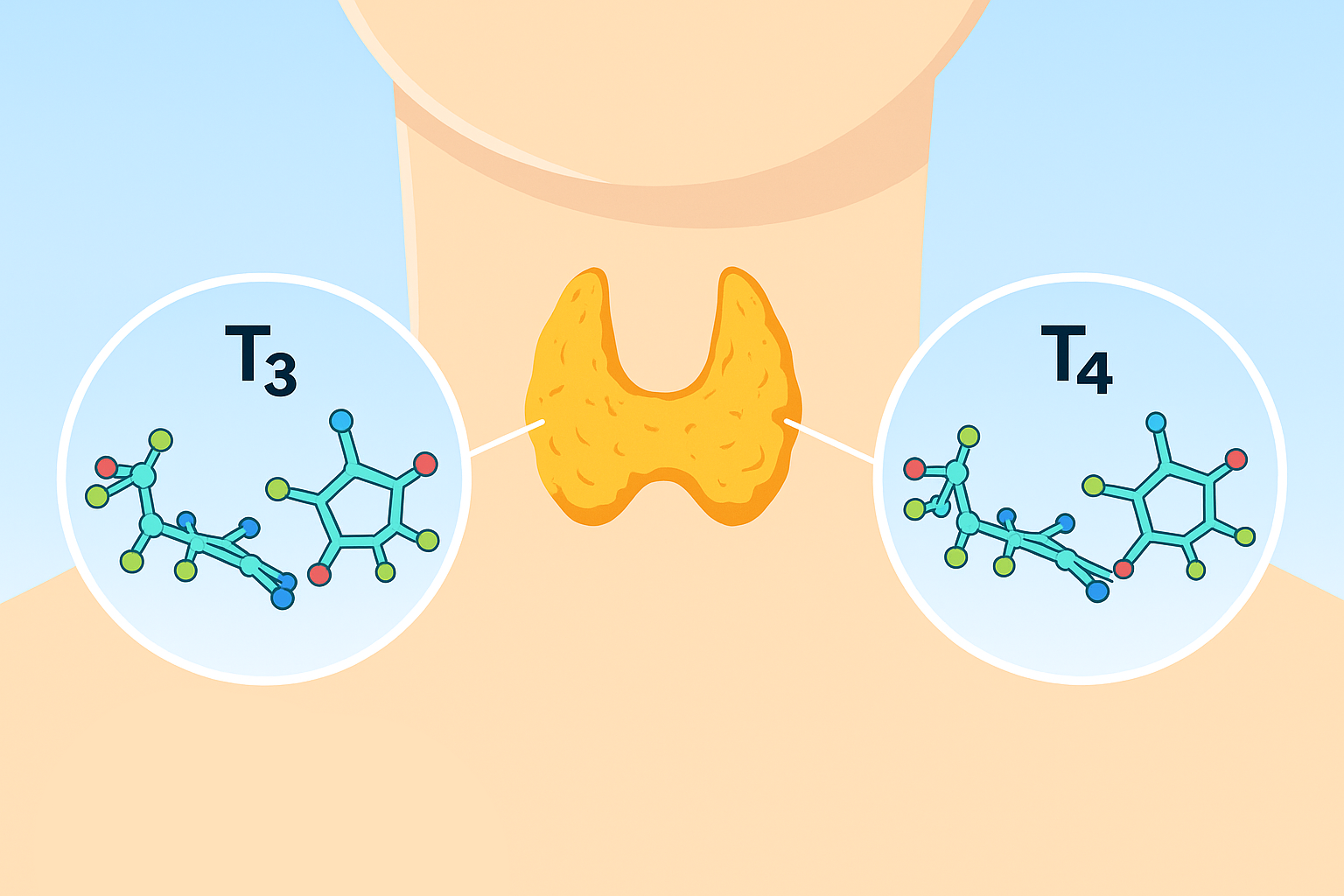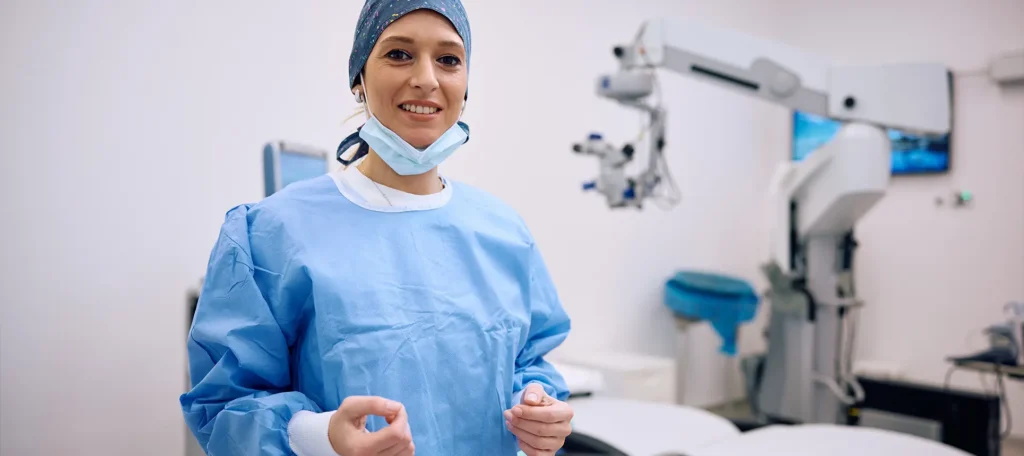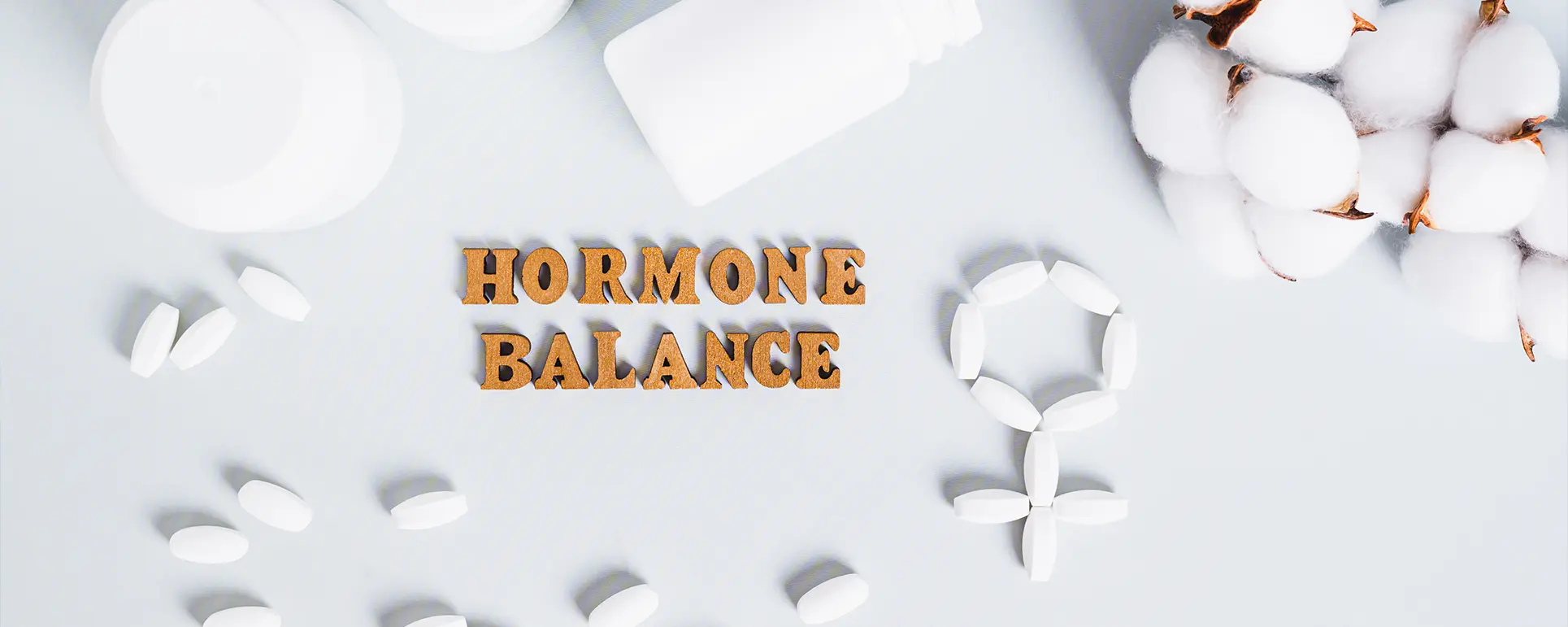When we think about cataracts, the first things that come to mind are ageing, UV exposure, and possibly genetics. But there’s a lesser-known factor that might be quietly influencing not just the development of cataracts—but also how well we recover after surgery. That factor is hormones.
In recent years, researchers have been digging deeper into the connection between our endocrine system and eye health, and the results are intriguing—especially for women. Hormones like oestrogen and thyroid hormones appear to have a significant influence on lens metabolism. These effects may even shape how cataracts develop and how the eye heals after surgery.
So in this article, we’re going to unpack what we currently know. We’ll look at the roles of oestrogen and thyroid hormones, explore the implications for surgical planning, and review emerging research that’s putting hormones centre stage in cataract care.
The Lens: A Hormone-Sensitive Structure?
The human lens isn’t just a passive piece of optical equipment in your eye—it’s metabolically active, highly structured, and surprisingly vulnerable to systemic changes. Hormones play a crucial role in maintaining cellular function throughout the body, and the lens is no exception.
Oestrogen, thyroid hormones, and even cortisol have receptors in ocular tissues. This suggests the eye is not just indirectly influenced by hormones circulating in the bloodstream—it actively responds to them. Some research even hints that hormonal imbalances can speed up or slow down the ageing of the lens.
The key takeaway? The lens isn’t working in isolation. Its health is intricately connected to broader hormonal regulation. So, when hormone levels shift—whether during puberty, pregnancy, menopause, or due to thyroid dysfunction—the lens may also undergo changes that lead to cataract formation.
Oestrogen and Cataracts: What’s the Link?
A Protective Role?
There’s a growing body of evidence suggesting that oestrogen may play a protective role in lens health. Women typically develop cataracts at a slightly later age than men, and some researchers think oestrogen could be the reason. It has antioxidant properties that may help protect lens proteins from oxidative damage—a key factor in cataract formation.
Animal studies have shown that oestrogen deficiency leads to increased oxidative stress in the lens. This has led to speculation that menopause, with its marked drop in oestrogen levels, might contribute to accelerated lens ageing. Interestingly, some human studies have supported this by showing increased cataract prevalence in postmenopausal women.
Hormone Replacement Therapy (HRT)
What happens when oestrogen is reintroduced after menopause through hormone replacement therapy? The findings are mixed. Some studies have found that women on HRT have a lower risk of developing certain types of cataracts, particularly nuclear sclerosis. Others haven’t found a strong link or have even reported an increased risk, depending on the type and duration of HRT used.
This inconsistency may point to a more nuanced reality: timing, formulation, and duration of HRT all likely matter. More importantly, the interplay between oestrogen and other hormones could complicate the picture, which we’ll explore later.
Thyroid Hormones: Subtle But Significant Influences

Metabolic Regulators
Thyroid hormones are the body’s metabolic managers. They regulate how quickly cells turn over, how energy is used, and how efficiently waste is cleared. It’s easy to see how disruptions in this system might affect the lens—a structure reliant on protein stability, hydration balance, and clarity.
Hypothyroidism, characterised by low levels of thyroid hormone, has been linked in several observational studies to an increased risk of cataracts. The mechanism might involve slowed cellular metabolism, leading to accumulation of damaged proteins in the lens.
On the other end, hyperthyroidism may increase oxidative stress, another known contributor to cataractogenesis. However, direct evidence is still limited, and more large-scale studies are needed to draw firm conclusions.
Autoimmune Thyroid Disease
Autoimmune conditions like Hashimoto’s thyroiditis and Graves’ disease can also complicate the hormonal landscape. These conditions often fluctuate between hyper- and hypothyroid states, making it difficult for the body to maintain hormonal stability. This instability may accelerate ocular ageing and increase the risk of early cataract development.
In women—who are disproportionately affected by autoimmune thyroid disorders—this is especially relevant. Hormonal screening could potentially become part of preoperative assessment protocols in the future.
Cortisol and the Stress-Cataract Connection
Cortisol, the body’s main stress hormone, also plays a role in cataract formation—particularly if levels are chronically elevated. Prolonged stress or the use of corticosteroids (both systemic and topical) has long been associated with posterior subcapsular cataracts.
This isn’t just a biochemical curiosity. If you’ve been on steroid medication for an autoimmune disease, asthma, or even certain skin conditions, it could influence your lens health. Moreover, since hormonal dysregulation often occurs in clusters—thyroid dysfunction may co-occur with cortisol imbalances—it’s another factor worth watching when planning surgery.
Hormonal Milestones in Women: Critical Windows for Cataract Risk
Puberty and Pregnancy
During puberty and pregnancy, hormonal levels fluctuate significantly. Although there is little direct evidence linking these stages to permanent cataract changes, temporary shifts in vision are often reported. For instance, water retention associated with pregnancy hormones can subtly change the curvature of the cornea and the lens, leading to temporary blurring.
In rare cases, pregnancy can unmask underlying endocrine conditions like gestational thyroid dysfunction or diabetes, which may accelerate cataract formation.
Menopause and Beyond
Menopause represents one of the most hormonally disruptive periods in a woman’s life. With declining oestrogen levels, the eye loses some of its oxidative defence mechanisms. Combine this with age-related oxidative stress and you have a perfect storm for cataract progression.
Some clinicians have suggested this as a window for earlier surgical intervention—particularly if cataracts are beginning to affect quality of life and HRT is contraindicated. In such cases, timing surgery to minimise the impact of hormone withdrawal on healing is an emerging area of discussion.
Surgical Planning: When Hormones Should Be Part of the Conversation

You might be wondering—should cataract surgery timing actually depend on hormone levels? In many cases, no. But in hormonally sensitive or complex cases, it may be worth considering.
For instance, if a patient is undergoing treatment for thyroid disease and hormone levels are fluctuating, surgery might best be delayed until things are more stable. Similarly, in women transitioning off HRT, there may be value in timing the procedure before antioxidant protection diminishes further.
There is also a healing consideration. Oestrogen influences wound repair and inflammation, both key to post-op recovery. So declining hormone levels could hypothetically affect healing speed or risk of complications like posterior capsule opacification (PCO). At present, there’s no standard guideline—but the conversation has begun.
Healing Outcomes: Is There a Hormonal Fingerprint?
While the evidence is still emerging, several studies have begun to hint at hormonal influence over healing outcomes post-surgery.
- Inflammatory Regulation
Oestrogen has anti-inflammatory properties. In the context of cataract surgery, this could mean less post-op inflammation and quicker visual recovery. Some animal studies have shown that oestrogen-deficient models have a slower healing response and more fibrosis in lens capsule tissues. - Cell Proliferation and Tissue Remodelling
Thyroid hormones play a role in tissue regeneration and protein synthesis. If levels are too low or unstable, healing might be slower. In particular, thyroid dysfunction has been linked with dry eye and ocular surface instability—factors that can significantly impact recovery comfort and visual outcomes. - Corticosteroid Sensitivity
Patients with a history of steroid use may also have altered healing profiles. Some may be more prone to raised intraocular pressure after surgery, or develop steroid-induced cataracts in the contralateral eye if therapy is ongoing.
What This Means for Women Considering Cataract Surgery
If you’re a woman approaching or beyond menopause, with a history of thyroid dysfunction or hormone-related conditions, this information may help you make more informed decisions.
Here are a few things to consider:
- Discuss Hormonal History: Let your ophthalmologist know if you’re on HRT, thyroid medication, or corticosteroids.
- Get Baseline Hormone Testing: Especially if symptoms of imbalance are present (fatigue, dry eyes, vision changes).
- Plan for Optimal Timing: If possible, time your surgery when hormonal status is relatively stable.
- Ask About Recovery Expectations: Some women may need closer monitoring during healing, especially if hormone levels are low.
This is not about overcomplicating things—it’s about personalising your care. Cataract surgery is one of the most successful procedures in modern medicine, but understanding how your hormones interact with your eyes could give you an even smoother experience.
Frequently Asked Questions
- Can hormonal imbalances actually cause cataracts, or do they just speed them up?
Hormonal imbalances don’t typically cause cataracts outright—but they can definitely speed up the process. The lens of your eye is highly sensitive to oxidative stress, and hormones like oestrogen and thyroid hormones help regulate metabolic activity and antioxidant defence. So when those hormones are out of balance—due to menopause, thyroid disease, or long-term corticosteroid use—the lens can age more rapidly. This may lead to earlier onset or faster progression of cataracts in some individuals. - Should I delay cataract surgery if I’m currently experiencing hormonal fluctuations?
It depends on the nature and severity of the fluctuations. For example, if your thyroid levels are unstable or you’re undergoing changes in hormone therapy (like starting or stopping HRT), it might be worth waiting until things settle. Hormonal instability can sometimes impact both surgical outcomes and healing speed. However, delaying surgery should always be weighed against the impact of poor vision on your daily life. A consultation with your ophthalmologist, and possibly an endocrinologist, is the best way to decide. - Does hormone replacement therapy (HRT) protect against cataracts?
The research is mixed. Some studies suggest that HRT, especially oestrogen-only regimens, may offer a protective effect—potentially by enhancing antioxidant activity in the lens. However, other studies show no benefit, or even a possible increased risk depending on the duration and type of therapy. What’s becoming clearer is that the timing, dose, and formulation of HRT all influence its impact. HRT shouldn’t be started solely for cataract prevention, but its potential effects on eye health are worth discussing with your doctor. - Do thyroid problems affect recovery after cataract surgery?
Yes, they can. People with untreated or unstable thyroid conditions—particularly hypothyroidism—may have a slower wound-healing response and a higher risk of postoperative dry eye symptoms. Thyroid hormone plays a role in cell regeneration and tissue repair, both of which are crucial in the recovery period. Ensuring your thyroid condition is well-managed before surgery may help support a smoother healing process. - Are there specific considerations for women going through menopause who are planning cataract surgery?
Absolutely. The drop in oestrogen that occurs during menopause can affect not just lens health but also tear production, inflammation, and healing speed. If you’re approaching or in menopause, and planning cataract surgery, it’s worth discussing your hormonal history with your surgeon. In some cases, the timing of the procedure may be adjusted to optimise recovery, especially if you’re transitioning on or off hormone therapy. - Can I have cataract surgery while pregnant or breastfeeding?
Cataract surgery during pregnancy is usually postponed unless absolutely necessary, mainly to avoid exposing the foetus to surgical stress, medications, or anaesthetic agents. Although the procedure itself is local and relatively safe, the hormonal changes during pregnancy—especially oestrogen and progesterone shifts—can affect corneal thickness and tear film stability, potentially complicating biometry or recovery. Breastfeeding poses fewer risks, but always consult your obstetrician and ophthalmologist to make an informed decision based on your specific case. - Does long-term steroid use always lead to cataracts?
Not always, but it significantly increases your risk—especially for a type called posterior subcapsular cataracts (PSC). This applies whether the steroids are taken orally, applied topically (e.g. for eczema), or used as inhalers. The longer and more frequently they are used, the greater the likelihood of developing lens opacities. If you are on chronic corticosteroid treatment for a condition like asthma or lupus, regular eye exams are essential, and your cataract surgeon may take this history into account when planning treatment. - Are bioidentical hormones safer for the eyes than conventional HRT?
There’s currently no strong evidence to suggest that bioidentical hormones offer more protection against cataracts or better post-op outcomes compared to standard HRT. Both forms of oestrogen interact with oestrogen receptors in the eye, and their effects likely depend more on timing, dose, and individual response than on their source. Research in this area is still limited, so if you’re using or considering bioidentical HRT, it’s worth discussing its potential ocular effects with both your GP and eye specialist.
Final Thoughts
As we continue to learn more about the endocrine system’s role in eye health, it’s becoming clear that hormones like oestrogen and thyroid regulators aren’t just background players. They may actively shape how and when cataracts develop—and even how well you recover after surgery.
Right now, the science isn’t definitive, but it’s moving in a direction that could lead to more tailored surgical planning. For women in particular, hormonal history may soon be considered as important as lens opacity or visual acuity in deciding when to operate.
If you’re considering cataract surgery and want to explore the best personalised care options available, especially in hormonally complex situations, you can book a consultation with one of our expert cataract surgeons at the London Cataract Centre. Our team understands that the eye doesn’t exist in a vacuum—it’s part of a much bigger picture, and your care should reflect that.
References
- Gupta, P.D., Johar, K., Nagpal, K. & Vasavada, A.R. (2005) ‘Cataract: an overview’, International Journal of Medical Sciences, 2(4), pp. 152–157. Available at: https://www.ncbi.nlm.nih.gov/pmc/articles/PMC1236943/
- Klein, B.E.K., Klein, R. & Lee, K.E. (2000) ‘Reproductive exposures, lens opacities, and age-related maculopathy: the Beaver Dam Eye Study’, American Journal of Ophthalmology, 130(4), pp. 447–448.
- Kim, J.H., Park, S.J., Kim, J.H., Park, K.H. & Woo, S.J. (2015) ‘Association between thyroid diseases and development of cataract: a nationwide population-based cohort study’, PLoS One, 10(3), e0119772. Available at: https://doi.org/10.1371/journal.pone.0119772
- Davis, P.J. & Goglia, F. (2019) ‘Thyroid hormones and mitochondrial function in oxidative stress’, Trends in Endocrinology & Metabolism, 30(6), pp. 390–402.
- Pinna, G., Cossu, M., Carta, F. & Argiolas, M. (2001) ‘Cataract and corticosteroid use: a review of literature’, Clinical Drug Investigation, 21(5), pp. 319–328. Available at: https://doi.org/10.2165/00044011-200121050-00005

